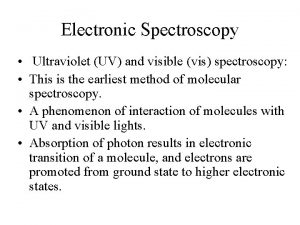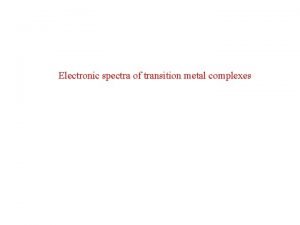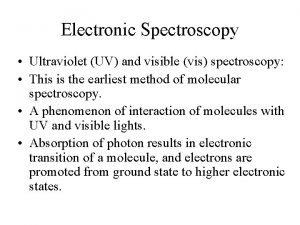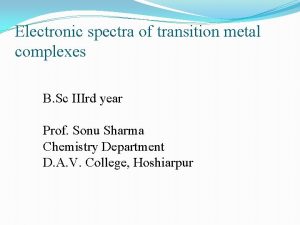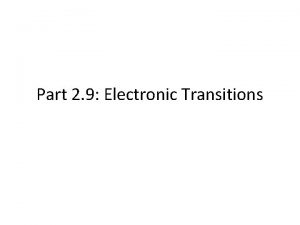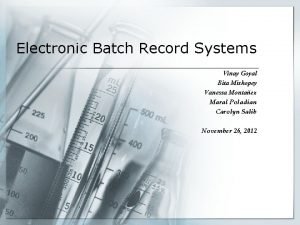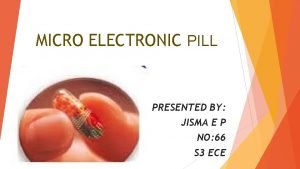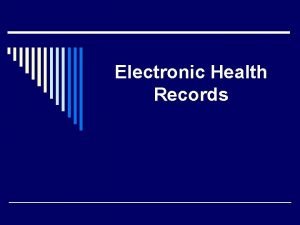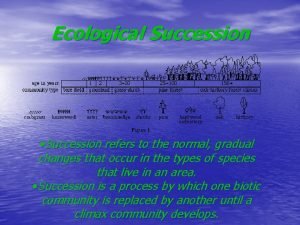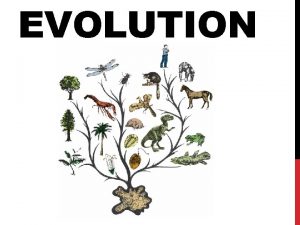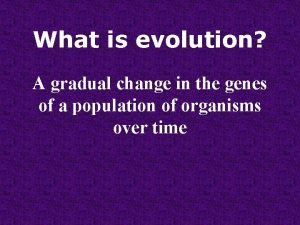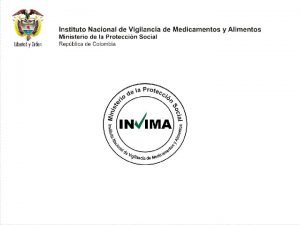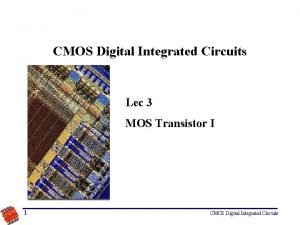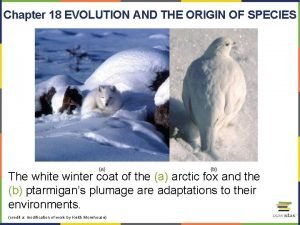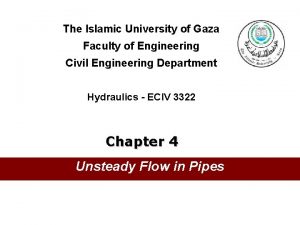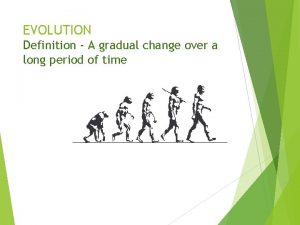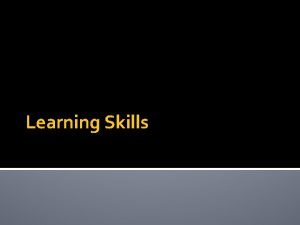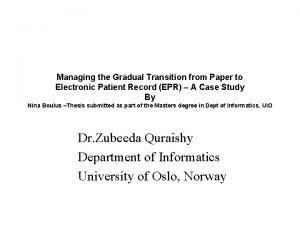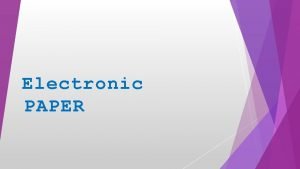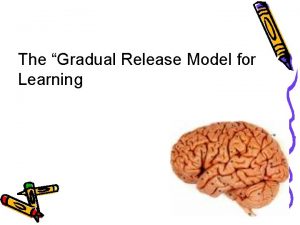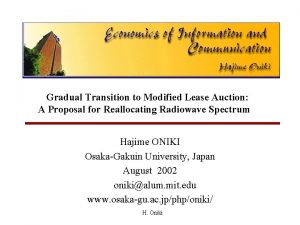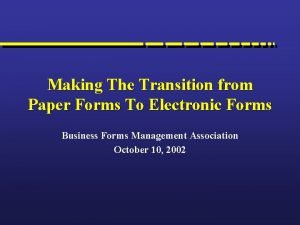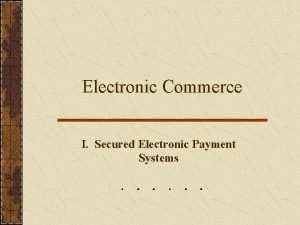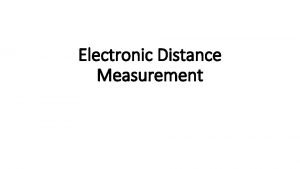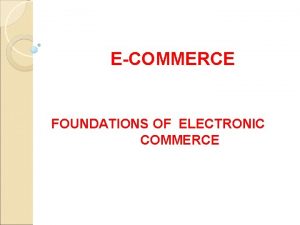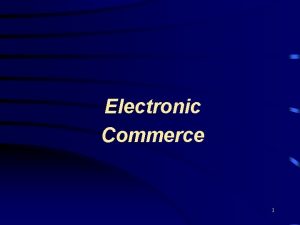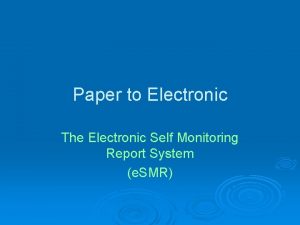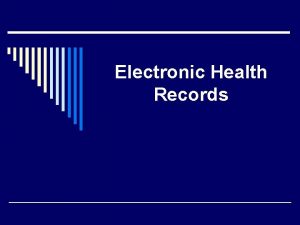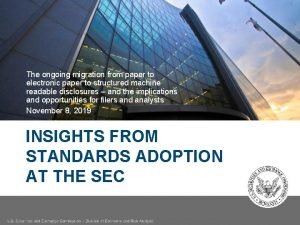Managing the Gradual Transition from Paper to Electronic

















































- Slides: 49

Managing the Gradual Transition from Paper to Electronic Patient Record (EPR) – A Case Study By Nina Boulus –Thesis submitted as part of the Masters degree in Dept of Informatics, Ui. O, May 2004 1

Thank you Nina u To highlight the different challenges a large scale project faces in implementing the electronic patient record in Rickshospitalet, a national hospital in Norway. 2

Why I chose the above case study for the class? Reasons u u 1. Many frameworks and theories are used particularly ANT which describes how, where and to what degree the technology influences human behaviour (Monterio, 2000) and particularly when trying to understand the roles and meanings of artifacts in social world or in work then this perspective creates a light on how human and non-human elements are intertwined and together creates heterogeneous sociotechnical network. This is important from the anthropological perspective. 3

u c. Moreover the author of the above case study instead of restricting to one framework or a theory has discussed the case study in various perspective thus giving us a deeper understanding of how technology is interlinked to its context. 4

Reasons for choosing the case study u 2. Helps us to develop a deeper understanding of the socio technical aspects of the complexities and challenges that emerge from the implementation of the EPR u 3. Describes the strategies to manage the gradual transition to digital record from the manual paper based records. 5

What is an EPR? u An Electronic Patient Record (EPR) electronic medium for storing clinical information. u Replicates the structure that is used in the paper based record and it accumulates all the information that is relevant for the treatment and nursing of a patient. 6

Why an EPR ? Seen as a solution for various problems in the health care organization u Increased demand for efficiency and quality as transformation is taking place from ‘Public sector’ to ‘Business culture’. u Increased focus on costs saving and documenting activities, efficient use of resources and benefits. u Not only to reduce the physical size of the paper records but to centralise and merge the paper based records into EPR. u 7

. Motivation for doing the above case study by the researcher u Proved to be a highly challenging task in spite of huge funding spent on the process of implementation by national and international agencies. EPR had great visions : To support managed care logic, redesign of work processes and improved quality of care ( Nilsson, Grissor and Aanestad, 2002) EPR were expected not only to replace the old fashioned, messy and inadequate paper records but to fundamentally transform and improve medical care ( Dick & Steen, 1991 in Nilsson et al, 2002, p 2). 8

Motivation for doing the above case study by the researcher However the transition to EPR has proved to be long and complex process where many goals have not yet been met and also it has not conveyed any dramatic changes or effectiveness. u Thus the complexity and the decrease in the expectations of the hospitals from the EPR. u EPR provides an opportunity to study the issues of scaling large information infrastructures u 9

Theoretical framework u Actor Network Theory (ANT) which is also used as a methodological theory to view information infrastructures. 10

Brief introduction of Actor Network Theory u u u ANT as a methodological theory has been used in this case study to understand information infrastructures (IIs). Main reason for choosing this theory - ANT provides a framework for the socio-technical aspects and views the technology as an actor on par with other actors This theory is important in the sense that it provides theoretical concepts for documenting a complex and heterogeneous socio-technical work practice with many actors. 11

Actor Network Theory Heterogeneous socio-technical network Human Non-human Focuses on the relations and interplay between these elements, rather than each actor separately. 12

Brief introduction of Actor Network Theory It brings forth to light how new technology affects and interacts with the various actors and vice versa indicating a mutual interaction process. u This theory has the advantage of viewing both the human and non human actors as linked elements in the networks (heterogeneous actor networks) u And more than focusing separately on each element the focus is on the interplay and relations between these elements. 13

(Cont. . )Brief introduction of Actor Network Theory As pointed out by Latour (1987) these heterogeneous actors in the network are constituted by various concerns, different degrees of power and different perceptions towards the technology and its benefits. u More important is there should be stability and alignment in the network and to achieve that there should be an agreement among the different actors (Latour, 1999) u 14

In brief ANT …. u Provides a better understanding of the network’s complexity, helping us to see how borderline issues and inscriptions are hidden in the links between the various actors. u Provides a deeper understanding of the process of translations and motivations of heterogeneous actors. 15

What is an Information infrastructure? u u Information infrastructures are more than just the physical facilities that are used to transmit, store, and process information ( data , voice and images). According to Hanseth and Monteiro, 1997, information infrastructure is a vast field that covers all kinds of use and use areas. 16

What is an Information infrastructure? u u involves political, social, organisation, human aspects and issues – from the development of industrial at national, regional or even the global level. Unlike isolated IS of the past IIs are considered as the ‘next generation’ of information systems(IS) as it will encompass the integration of large number of systems. 17

Reason for selecting the above perspective to view EPR – Helps to understand the patient record in a broader framework than the traditional information systems. – Rather than understanding the systems as single elements in an isolated fashion which are developed for specific purposes and are used by homogeneous group they are described as elements in a larger infrastructure, including both technological and social actors. 18

Reason for selecting the above perspective to view EPR – An infrastructure is a socio-technical network, which includes more than just technological components. It includes actors, knowledge, use situation and procedures around them. – Infrastructures are heterogeneous in the sense that they include elements of different qualities, humans and computers. 19

anti-reductionist perspective of ecologies… – Important to view infrastructure as a shared irreducible unit which includes heterogeneous and tightly interconnected components , such as humans, technological components, organizations and institutions thus making it impossible to understand infrastructures as separate and independent entities. 20

Key features of IIs u They evolve continuously through extensions and improvements and over a period the infrastructures develop the scope of including new applications and the number of users and use areas increases giving it the feature of being ‘open’ and ‘scaled’. . u There is no time frame for development leaving it open(no defined beginning or ending), Hanseth, 2002). 21

Key features of IIs u Also infrastructures are developed through extensions and improvements of the installed base. In other words infrastructures are never built from scratch but rather developed by interrelating and inter connecting existing components. 22

Implications for Change u Unlike in traditional information systems there is complexity and unpredictability in IIs. u Traditional IS design is different from the design of IIs in several perspectives. Traditional ISs design methodologies focus on the development of a closed systems meaning single, isolated and stand alone systems (Hanseth, 2002). and design phase follows a closed time frame which is supposed to have pre-defined start and ending time frame(Orlikowski, 1996). . u 23

(Cont. . )Implications for Change IIs do not have to be built from the scratch but built upon the installed base. u As a result, the role of the installed base becomes crucial as it heavily influences the design of the new elements. u When implementing complex Information infrastructure it is best to adopt an evolutionary approach. u 24

Implications of adopting evolutionary approach u In evolutionary approach the installed base is seen as a design starting point (Hanseth, 1996). As a result, sub-networks are being changed following step-wise incremental changes at alignment, while aligning the new components with the rest of the network. This increases the chances for a successful transition over time between stability and flexibility(change) for the different components(Hanseth, Monteiro, Halting 1996). 25

Importance of transition strategies u Information infrastructures have to gradually evolve and scale through extensions and improvements , in order to meet the new requirements. But scaling an information infrastructure as pointed out by Montiero is neither trivial nor automatic but a process caught in a dilemma(Monteiro, 1998, p 230) involving pressure for change and at the same time demanding negotiation and balance against the conservative influence of the existing installed base. u Changing a large and complex infrastructure, such as the medical information infrastructure is profoundly challenging. 26

Why it is challenging? The challenge lies not in changing paperbased records in to electronic media but how the process of change and the evolution itself will be managed. u Thus a transition strategy should be a descriptive plan which outlines each evolutionary step including negotiations about how big changes can or have to be made, where to make them, and when and which sequence to deploy them (Monteiro, 1998, p. 230) u 27

Information infrastructure theory applied to EPR studies from different perspective of the researchers u Various studies have been conducted that analyse and describe information infrastructureu How record plays a role as an organsational infrastructure, how it serves various aims as well as allowing interplay and coordination of different worlds(Berg and Bowker, 1997). 28

Information infrastructure theory applied to EPR studies from different perspective of the researchers u EPR is not only a complex project in their work but also highlighted the resources beyond the record itself (Ellingson and Monteiro, 2000). u EPRs as part of large, complex, interconnected and irreversible networks(Hanseth and Monteiro, 1997). 29

Information infrastructure theory applied to EPR studies from different perspective of the researchers – Lundberg(2000) in her study of digitalization of radiological practices have emphasized the importance of network and information infrastructure perspectives. – Considering the above views it becomes clear that there is a need for Information Infrastructure perspective and many researches have contributed with insightful studies of the challenges and strategies for designing information infrastructure. . – There are researchers who also stress on the implications of implementing II and rather than just present II as a challenge. 30

Information infrastructure theory applied to EPR studies from different perspective of the researchers – Since currently EPRs in the Norwegian Health Care have been developed and implemented with traditional IS thinking many hospitals are struggling to integrate these complex and rigid systems with other, both existing and newly developed systems, in order to expand create a sufficient IIs. (Nilsson et al, 2002, p 6). – The above authors emphasize that there is a need to analyse the existing body of knowledge regarding how to develop such technologies, and to study the implications of the Information Infrastructure perspective(Nilsson et al, 2002) 31

IT & Work Practice u In order to understand how the electronic patient record affects the medical work, knowledge should be firstly acquired about the organization of the medical work practice, cooperative work in teams and the use of the artefacts in the medical work. u Support the design of systems that are adapted to the existing work practice in a better way than the traditional information system design. u For that the author uses theoretical framework by applying work practice oriented concepts such as ‘ situated practice of use” and emphasize the use aspect in situated practices. 32

IT & Work Practice u It is a dynamic reflexive process where information infrastructures are also locally shaped and re-invented through situated practice of use (The Boomerang effect in Design and Use of Information Infrastructures: Evidence from a Global company, Rolland, K, 2002 b, Draft submitted to the Information and Organisation journal). u Rolland’s concepts helps us to explore not only the complex interplay that exists between context dependent and situated practices of uses and various process of innovation of Information infrastructures but also the implications that result out of it. u Using the perspective of information infrastructures one can see how the community of practice( i. e, organization, people)is ordered, how information is retrieved and changed etc. 33

Research methods u Qualitative research methods: – Helping to understand people and social and cultural phenomena. – The researcher does not try to control or predict, but rather to understand the social world – Natural settings – Employs various methods u Weaknesses: – – – Possibilities of different interpretations of the same phenomena Limited possibilities for generalizing Time consuming 34

The empiriacl Field work u 19 Interviews u 14 sessions of observations (39 hours) u 5 Docu. Live courses (18 hours) u Pre-ward meetings u Shadowing session u Various formal and informal meetings 35

Empirical Material u The implementation process of Docu. Live EPR Parkinsons case Internal electronic referral letters The scanning project 36

Implementing the EPR 1. The development and implementation phase 2. The adaptation phase 3. The impact and effect of the EPR The author of the study looked on several aspects: – – – The use of the system Changes in the work practice Learning and discovering Complexities and challenges Advantages and disadvantages 37

Parkinsons case Illustrates the socio-technical infrastructure that cross disciplines, ISs, and work practices. u A complex and long process- interdisciplinary from various departments u Mapping pre-operative and post-operative procedures, and patient care processes. u Includes a detailed narrative description and graphical representation. u Shows how the medical practice is highly complex, dynamic, distributed, and regulated. u 38

Internal Electronic ref. letters u A pilot-project between the NEV(neurology) and the physiotherapy department. – The work practice before – The altered work practice 39

Paper-based referral letter 40

The Work Practices Before 41

Electronic-based referral letter 42

The work practices after: 43

Internal Electronic ref. letters u Challegnes: – Division of labour – It became important to distinguish between: u”Requested by”/vs. / ”signature” u”The person treating” /vs. / ”the person responsible for the treatment” 44

The Scanning Project u Implies scanning a huge amount of papers that are in the central archive, and integrating them in the EPR. – Motivations – Scanning strategy – Expected challenges – Initial experience 45

Analysis 1 u The installed base carries heritage u The installed base had to gradually evolve and scale through extensions and improvements u The hybrid installed base- lead to the need for integration u One way to integrate the various IT apply gateways 46

Analysis 2 u u u The transition process is not merely a transformation of IIs. The transition is rather mutual, dynamic, and reflexive transformation process of both II and situated practice of use. Therefore Hold infrastructural focus together with a work practice orientation and use focus. The parkinsons case explores the complexity of the work practice. The transformation to the EPR: – No radical changes in the traditional sequence of activites. – Changes only in the performance of the activities and in the interdependencies. static objects 47

(Cont. . ) Analysis 2 u Work practice is linked and supported by a long chain of artefacts. u Inscriptions identified in the paper-based record. u The paper-based record part of a larger infrastructure that accumulates a group of boundary objects. u Paper-based referral letters are more than just 48

Analysis 3 u Translating paper-based to electronic records implies that the coordination role of the paper document will be lost, and must be replaced by the IS. u Managing a gradual transtion can be done by conducting extensions and improvements of the installed base, and identifying borderline issues and establishing gateways. 49
 Scrip exchange
Scrip exchange Electronic news gathering and electronic field production
Electronic news gathering and electronic field production Woodward fieser rules examples
Woodward fieser rules examples Franck condon principle
Franck condon principle Racah parameter
Racah parameter Selection rule for electronic transition
Selection rule for electronic transition Electronic spectra of transition metal complexes
Electronic spectra of transition metal complexes Selection rule
Selection rule Vinay goyal md
Vinay goyal md Microelectronic pill
Microelectronic pill Paper vs electronic medical records
Paper vs electronic medical records Gradual dose reduction guidelines cms 2019
Gradual dose reduction guidelines cms 2019 Frost action
Frost action Ecological succession refers to
Ecological succession refers to The gradual change in a species over time
The gradual change in a species over time Gradual change
Gradual change A gradual change in a community over time.
A gradual change in a community over time. Plan gradual de cumplimiento
Plan gradual de cumplimiento Gradual channel approximation
Gradual channel approximation The origin of species chapter 18
The origin of species chapter 18 The gradual development of a community over time
The gradual development of a community over time A substituição ordenada e gradual
A substituição ordenada e gradual Fluid mechanics
Fluid mechanics Plan gradual de cumplimiento
Plan gradual de cumplimiento Transforma los adjetivos en adverbios. constante
Transforma los adjetivos en adverbios. constante Water hammer calculation
Water hammer calculation Natural selection definition
Natural selection definition Natural selection definition biology
Natural selection definition biology Opposition principle of design
Opposition principle of design Build up skills
Build up skills Gradual channel approximation
Gradual channel approximation Gradual release of responsibility pedagogy
Gradual release of responsibility pedagogy Aice english paper 2
Aice english paper 2 Aice topics
Aice topics Voi kéo gỗ như thế nào
Voi kéo gỗ như thế nào Thiếu nhi thế giới liên hoan
Thiếu nhi thế giới liên hoan điện thế nghỉ
điện thế nghỉ Vẽ hình chiếu vuông góc của vật thể sau
Vẽ hình chiếu vuông góc của vật thể sau Một số thể thơ truyền thống
Một số thể thơ truyền thống Trời xanh đây là của chúng ta thể thơ
Trời xanh đây là của chúng ta thể thơ Thế nào là hệ số cao nhất
Thế nào là hệ số cao nhất Hệ hô hấp
Hệ hô hấp So nguyen to
So nguyen to đặc điểm cơ thể của người tối cổ
đặc điểm cơ thể của người tối cổ Các châu lục và đại dương trên thế giới
Các châu lục và đại dương trên thế giới Tư thế worms-breton
Tư thế worms-breton ưu thế lai là gì
ưu thế lai là gì Tư thế ngồi viết
Tư thế ngồi viết Bàn tay mà dây bẩn
Bàn tay mà dây bẩn



